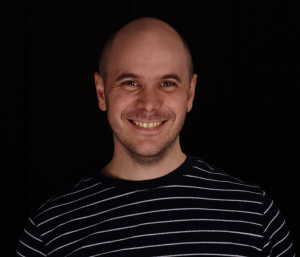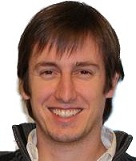Der Förderverein Technische Fakultät an der Alpen-Adria-Universität Klagenfurt wünscht allen Mitgliedern ein frohes Weihnachtsfest und einen guten Start in ein erfolgreiches Jahr 2015!
CECC 2015: 15th Central European Conference on Cryptology
25. November 2014
The 15th Central European Conference on Cryptology, CECC 2015, is organised by the Institute of Mathematics and the System Security Group of Alpen-Adria-Universität Klagenfurt.
The conference will be held in Klagenfurt am Wörthersee, Austria, on July 8-10, 2015, at the university campus.
The aim of the conference is to gather researchers interested in discussing recent advances in all aspects of cryptology, including but not limited to:
- cryptanalysis
- cryptographic applications in information security
- design of cryptographic systems
- encryption schemes
- general cryptographic protocols
- post-quantum cryptography
- pseudorandomness
- signature schemes
- steganography
All participants are encouraged to present a contributed talk. Registration and abstract submission will be opened on December 15, 2014.
Further information at https://www.math.aau.at/cecc2015/
Posted in Veranstaltungen Kommentare deaktiviert für CECC 2015: 15th Central European Conference on Cryptology
Österreichische Computer Gesellschaft (OCG): Förderpreis
17. November 2014
Ausschreibung 2015: Die Ausschreibung für den OCG Förderpreis 2015 endet am 9. Dezember 2014
Motivation
Die OCG verleiht zur Förderung der Informatik und Wirtschaftsinformatik jährlich den OCG-Förderpreis.
Ziel
Die Förderung von hervorragenden Diplom- bzw. Magisterarbeiten
Zielgruppe
Alle Studentinnen und Studenten mit Diplomarbeiten bzw. Magisterarbeiten auf dem Gebiet der Informatik, Wirtschaftsinformatik und ihren Anwendungen
Konzept
Zur Bewerbung ist ein Online-Formular auszufüllen, die zu prüfende Arbeit, eine (max. zehnseitige) Kurzfassung sowie ein ausführliches Literaturverzeichnis sind auf der OCG Website innerhalb der Einreichfrist hochzuladen.
Eine Erstreckung der Einreichfrist ist nicht möglich.
Voraussetzung
Die eingereichte Arbeit muss innerhalb der letzten zwei Jahre an einer österreichischen Universität approbiert worden sein. Die eingereichten Unterlagen verbleiben bei der Österreichischen Computer Gesellschaft.
Preise
Der OCG-Förderpreis wird mit Euro 2.000,- dotiert.
Jury
- Prof. Dr. Günter Haring (Vorsitz)
- Prof. Dr. Martin Hitz
- Prof. Dr. Gerti Kappel
- Prof. Dr. Gabriele Anderst-Kotsis
- Prof. Dr. Gustaf Neumann
- Prof. Dr. Franz Wotawa
Posted in News Kommentare deaktiviert für Österreichische Computer Gesellschaft (OCG): Förderpreis
Efficient retrieval using models based on feature signatures
10. November 2014
Abstract: Recent trends in large-scale image retrieval consider image representations based on the Bag of Visual Words model, because such representation enables efficient filtering using inverted files, while for more effective retrieval the representation can be enhanced by VLAD or Hemming embedding. In order to improve the effectiveness of the retrieval even more, some models try to relax from Bag of Visual Words model (i.e., from a shared feature space dictionary) and model content of multimedia objects by means of so-called feature signatures. Whereas the effectiveness of models based on feature signatures seems to be promising for several retrieval tasks, the efficiency of the models still represents a serious performance bottleneck, because the models employ expensive adaptive distance measures to compare two feature signatures. In this talk, we present several recent approaches that significantly improve the efficiency of the retrieval when using models based on feature signatures, making the models applicable also for large-scale image retrieval.
CV: Jakub Lokoc received the doctoral degree in software systems from the Charles University in Prague, Czech Republic. He is an assistant professor in the Department of Software Engineering at the Charles University in Prague, Faculty of Mathematics and Physics, Czech Republic. He is a member of siret research group and his research interests include metric access methods, multimedia retrieval and exploration, and similarity modeling.
Posted in TEWI-Kolloquium Kommentare deaktiviert für Efficient retrieval using models based on feature signatures
Rückblick: Quality of Experience – Why Bother? [Slides][Video]
4. November 2014
Der Rückblick zum TEWI-Kolloquium von Martin Varela am 27.10.2014 beinhaltet die Videoaufzeichnung sowie die Folien:
Video
[iframe height=“350″ src=“http://video.aau.at/video.php?video=ftf_valera.mp4″]
Slides
Abstract: In this talk I’ll discuss some ideas about the reasons, both technical and business-related why we care about Quality of Experience (QoE). I’ll present some results related to QoE-driven network and application-level management, and first steps into economically exploiting QoE models, in particular concerning Service Level Agreements, as well as some enablers for doing so.
Bio: Martín Varela received his PhD and MSc from the University of Rennes 1 (Rennes,France), in 2005 and 2002 respectively. He has been an ERCIM fellow, and spent time at SICS and VTT, where he is currently a Principal Scientist. His research interests lie in the QoE domain, with a particular focus on real-time QoE estimates for generic services and applications thereof. He is currently leading VTT’s work on QoE, and is a Finnish management committee member for COST Action IC1003 Qualinet. He has also served as Scientific Coordinator for the Celtic Plus QuEEN project. He is currently co-chair for the IEEE MMTC QoE Interest Group.
Posted in TEWI-Kolloquium Kommentare deaktiviert für Rückblick: Quality of Experience – Why Bother? [Slides][Video]
CONTINUOUS TIME BAYESIAN NETWORKS FOR MINING STREAMING DATA
3. November 2014
Abstract: Streaming data are relevant in finance, computer science, and engineering while they are becoming increasingly important in medicine and biology. In particular, classification, clustering and structural learning of streaming data are receiving increasing attention. These tasks require algorithms and models capable to represent dynamic, sequence and time. Dynamic Bayesian networks and hidden Markov models are used to analyze streaming data. However, these models are concerned with equally spaced time data and thus suffer from several limitations because it is not clear how to discretize timestamps. The talk introduces continuous time Bayesian networks and continuous time Bayesian networks classifiers. Algorithms for parametric and structural learning of continuous time Bayesian network models to solve classification, clustering and structural learning based on multivariate discrete state continuous time trajectories are described. Stationary and non-stationary continuous time Bayesian networks are presented together with their structural learning based on the marginal likelihood approach. Numerical experiments concerning real world applications in finance, biomedicine, neurology and biology are presented.
CV: Prof Fabio Stella is an associate professor at the Dipartimento di Informatica, Sistemistica e Comunicazione of the Università degli Studi di Milano-Bicocca. His research focuses on models and algorithms for data analysis and decision making under uncertainty in the areas of Business Intelligence, Data and Text Mining and Computational Finance. In the winter term 2014/15 he is giving the course 625.605 – Business Intelligence in Klagenfurt.
Posted in TEWI-Kolloquium Kommentare deaktiviert für CONTINUOUS TIME BAYESIAN NETWORKS FOR MINING STREAMING DATA
xamoom sucht zwei EntwicklerInnen
17. Oktober 2014
 Wir werden alles tun, um ein großartiges Klima für eine spannende, kreative und herausfordernde Arbeit zu schaffen. Wir werden zudem viel Gestaltungsspielraum und Mitsprache bieten.
Wir werden alles tun, um ein großartiges Klima für eine spannende, kreative und herausfordernde Arbeit zu schaffen. Wir werden zudem viel Gestaltungsspielraum und Mitsprache bieten.
Schick’ uns deine Bewerbung bis 30. November 2014 an xamoom GmbH | Bruno Hautzenberger | Lakeside B01a, A-9020 Klagenfurt | bruno@xamoom.com
PDF version hier! Weitere Details unter http://www.xamoom.com/.
Android & Web
Du wirst dein Können im Bereich mobiler Entwicklung für Android und modernen Webapplikationen in einem Startup einbringen können.
Was du mitbringst
- Ausbildung im Bereich Informatik, Informationstechnik oder Vergleichbares
- Idealerweise zwei bis drei Jahre einschlägige Berufserfahrung
- Kenntnisse im Bereich der mobilen Entwicklung von Android Apps (Android SDK)
- Kenntnisse im Umgang mit RESTful Webservices, Android Studio, Git
- Idealerweise Erfahrung mit ember.js (oder ver- gleichbaren Frameworks), Python, PHP, HTML5, jQuery, NoSQL, UI/UX Design, Inkscape/Adobe CC
iOS & Web
Du wirst dein Können im Bereich mobiler Entwicklung für iOS und modernen Webapplikationen in einem Startup einbringen können.
Was du mitbringst
- Ausbildung im Bereich Informatik, Informationstechnik oder Vergleichbares
- Idealerweise zwei bis drei Jahre einschlägige Berufserfahrung
- Kenntnisse im Bereich der mobilen Entwicklung von iOS Apps
- Kenntnisse im Umgang mit RESTful Webservices, xCode, Git
- Idealerweise Erfahrung mit ember.js (oder ver- gleichbaren Frameworks), Python, PHP, HTML5, jQuery, NoSQL, UI/UX Design, Inkscape/Adobe CC
Was ist xamoom?
Wir wollen ortsbezogene Handydienste (Location Based Services) allen zugänglich machen, die gute Ideen aber wenig Know-how und keine dicken Brieftaschen haben. Es gibt dafür jede Menge Anwendungsfälle – von Audioguides in Museen über den Tourismus bis hin zu Handel und sogar in der Gastronomie.
Wir sehen uns aber als Anbieter einer Service-Infrastruktur (basierend auf Googles Cloud Platform) und weniger als Solution-Provider. Wir sind sicher, dass es jede Menge Anwendungen gibt, an die auch wir noch nicht denken. Das wird selbst für uns extrem spannend!
Erzähl uns was über dich!
Können wir uns ein Bild deiner bisherigen Arbeiten machen? Gibt es Apps von dir im App Store? Code auf Github? Antworten auf Stackoverflow? Engagierst du dich wo? Super, her mit den Links!
Entlohnung
Für diese Position gibt es auf Basis von Vollzeitbeschäftigung ein Einstiegsgehalt von 33.600 Euro brutto im Jahr (2.400 Euro/Monat). Dies ist eine Überzahlung zum IT-Kollektivvertrag bei Einstufung in Tätigkeitsgruppe ST1.
Arbeitsumgebung
Unser Büro befindet sich im Lakeside Science- & Technology-Park. Verkehrstechnisch gut angebunde (Autobahn, Parkplätze und bald S-Bahn in der Nähe) gibt es auch Kinderbetreuungseinrichtungen, mehrere Restaurants in Gehreichweite sowie alle Infrastruktureinrichtungen einer mittelgroßen Universität.
Wir wollen Arbeitszeiten und -orten flexibel gestalten. Nach Absprache ist auch anteiliges Home-Office möglich.
Posted in Stellenausschreibungen Kommentare deaktiviert für xamoom sucht zwei EntwicklerInnen
Quality of Experience – Why Bother?
15. Oktober 2014
 Abstract: In this talk I’ll discuss some ideas about the reasons, both technical and business-related why we care about Quality of Experience (QoE). I’ll present some results related to QoE-driven network and application-level management, and first steps into economically exploiting QoE models, in particular concerning Service Level Agreements, as well as some enablers for doing so.
Abstract: In this talk I’ll discuss some ideas about the reasons, both technical and business-related why we care about Quality of Experience (QoE). I’ll present some results related to QoE-driven network and application-level management, and first steps into economically exploiting QoE models, in particular concerning Service Level Agreements, as well as some enablers for doing so.Posted in TEWI-Kolloquium Kommentare deaktiviert für Quality of Experience – Why Bother?
Life at YouTube: An Engineering Perspective
6. Oktober 2014
- Life at YouTube: An Engineering Perspective
- What is Content ID (Tech Talk)
- Career Opportunities
- Q&A
WHO:
- Thomas Walland
- Technical Program Manager
- YouTube/Google
WHEN:
- 11. November 2014, 16:00
- Duration: ca. 2h, then snacks, drinks & chat
WHERE:
- Alpen-Adria Universität,
- Klagenfurt
- Room Z.1.09
WHY: To do cool things that matter!
DETAILS:
- Entrance free of charge but …
- Registration is required: goo.gl/fyNaHl
What is Content ID?
Copyright owners can use a YouTube specific system called Content ID to easily identify and manage their content on YouTube. Videos uploaded to YouTube are scanned against a database of files that have been submitted by content owners. Copyright owners get to decide what happens when content in a video on YouTube matches a work they own. When this happens, the video gets a Content ID claim.
About Thomas (Bio)
- Graduated from HTL Mössingerstrasse in 2001
- Graduated from Alpen-Adria Universität Klagenfurt in 2007
- Product Manager @ Upper Network in Graz, AT
- Product Manager @ Bwin.party digital entertainment in Vienna, AT
- Product Manager @ Scout24 Schweiz AG in Flamatt, CH (close to Bern)
- Technical Program Manager YouTube @ Google Switzerland in Zurich, CH
- For more details, check out my LinkedIn profile or reach out to thomas.walland@gmail.com
Posted in TEWI-Kolloquium Kommentare deaktiviert für Life at YouTube: An Engineering Perspective
Rückblick: Perspectives on Software Visualization [Video][Slides]
10. September 2014
Der Rückblick zum TEWI-Kolloquium von Dr. Fabian Beck am 03.09.2014 beinhaltet die Videoaufzeichnung sowie die Folien:
Video
[iframe height=“350″ src=“http://video.aau.at/video.php?video=ftf_beck.mp4″]
Slides
[iframe src=“http://www.slideshare.net/slideshow/embed_code/38904796″ width=“476″ height=“400″ frameborder=“0″ marginwidth=“0″ marginheight=“0″ scrolling=“no“]
Abstract
Abstract: Software visualization addresses the visual representation of software systems, their dynamic execution, and their development process. In this context, diagrams can help software developers, software architects, or researchers understand and analyze the system, to finally improve the software and development process. Those different roles, however, come along with different perspectives and requirements for visualization tools. In my talk, I will give recent examples from my own work how those diverging perspectives can be addressed: On the one hand, high-level visualizations showing complete software systems and their evolution might be leveraged by architects and researchers. On the other hand, small visualizations embedded in the code could support developers in their daily work extending and optimizing the code. Finally, I want to conclude by giving an outlook on future perspectives on software visualization.
Biography
Fabian Beck is a postdoctoral researcher at VISUS, University of Stuttgart, Germany. In 2013, he obtained his Dr. rer. nat. (PhD) degree in computer science from University of Trier. In his dissertation, he investigated multi-dimensional coupling graph structures of software systems. In general, most of his research is focused on methods for visualizing and comparing large and dynamic graphs and hierarchies, often in the context of software systems and their evolution. In recent projects, he also studies the use of word-sized visualizations embedded in source code and text.




